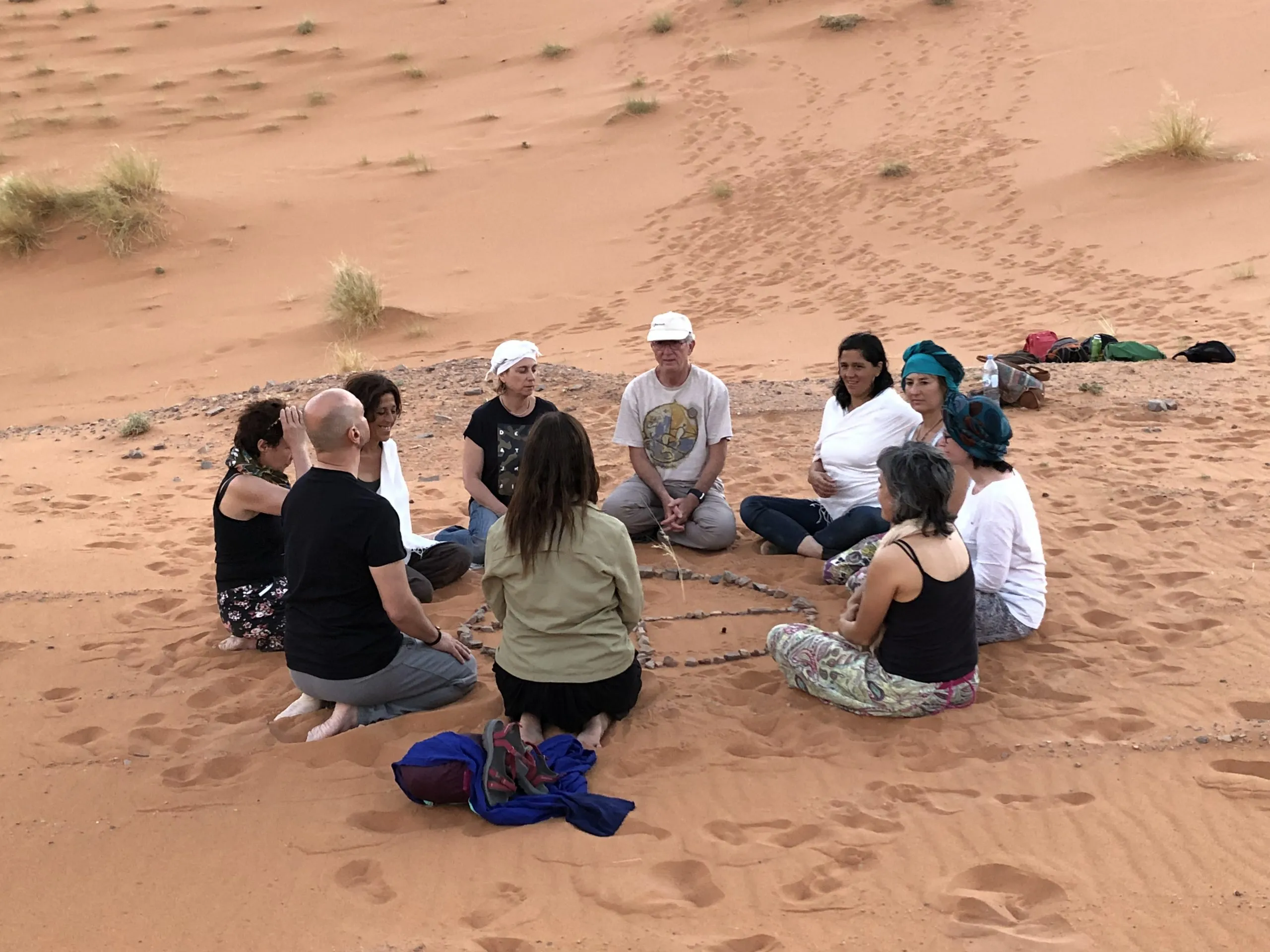
The importance of refuges as foundations of resilience has been highlighted by authors such as Peter Levine in “Waking the Tiger: Healing Trauma” (1997), where the body’s innate capacity to heal and recover is explored through practices that induce sensory and emotional refuges. These refuges act as buffers against stress and contribute to maintaining emotional homeostasis. In the context of ecopsychotherapy, natural refuges offer a space to process and heal trauma, as well as to address conditions such as eco-anxiety and climate anxiety.
To apply these refuges in trauma work, techniques such as immersion in natural environments can be used, where direct contact with nature can activate relaxation responses and promote emotional self-regulation. The practice of mindfulness in nature can also be effective, allowing individuals to reconnect with their bodily sensations in a safe and calm environment.

Differentiation with Defense Mechanisms
The crucial distinction between refuges and defense mechanisms has been addressed by Gabor Maté in “When the Body Says No: The Cost of Hidden Stress” (2003). While defense mechanisms are unconscious strategies to protect oneself from emotional pain, refuges are conscious places of emotional support that foster authenticity and self-regulation. Defense mechanisms can lead to disconnection and avoidance, while refuges promote presence and personal growth.
Expanding this differentiation, it is important to understand that refuges provide a space for self-exploration and self-understanding without the pressure of directly confronting sources of stress or trauma. In ecopsychotherapy, this translates into the creation of safe natural spaces, living metaphors, or understanding of life-sustaining principles, where individuals can experience a break from daily stress and, in turn, work on their personal growth in a more authentic and sustained way.
Refuges and Ecopsychology

Refuges such as trees, the sea, skin, silence, and beauty align with Edward O. Wilson’s (1984) idea of “Biophilia,” which suggests that humans have an innate affinity with other life forms. This affinity helps us find solace and meaning in nature, acting as reminders of our intrinsic connection to life in all its forms.
Authors such as Theodore Roszak, in “The Voice of the Earth” (1992), Mary-Jayne Rust (2014), and Andy Fisher (2013) have also delved deeper into this idea, exploring how ecopsychology can help people reconnect with nature in ways that promote psychological and emotional healing. David Abram, in “The Spell of the Sensuous” (1997), highlights the importance of direct sensory perception and active engagement with the natural world as means of rekindling our connection to the earth.
Neuroscience and Refuges
 From a neuroscientific perspective, Stephen Porges in “The Polyvagal Theory: Neurophysiological Foundations of Emotions, Attachment, Communication, and Self-regulation” (2011) highlights how activation of the vagus nerve through pleasant stimuli, such as those from natural emotional refuges, induces states of calm and well-being. The connection between sensory experience and neurobiological regulation highlights the importance of refuges in emotional self-regulation.
From a neuroscientific perspective, Stephen Porges in “The Polyvagal Theory: Neurophysiological Foundations of Emotions, Attachment, Communication, and Self-regulation” (2011) highlights how activation of the vagus nerve through pleasant stimuli, such as those from natural emotional refuges, induces states of calm and well-being. The connection between sensory experience and neurobiological regulation highlights the importance of refuges in emotional self-regulation.
Nature, with its ability to provide varied and enriching sensory stimuli, acts directly on emotional regulation, promoting recovery from traumatic situations and resilience. The practice of Ecotherapy and Ecopsychotherapy, which includes techniques such as forest therapy and immersion in natural environments, uses these principles to facilitate emotional healing.
Refuges in Ecopsychotherapy:
Let’s look at some practices that, when used for the purpose of creating spaces of refuge in people, become powerful tools for working with anxiety disorders, stress and trauma:
- Natural Trails: Walking along natural trails, forests or mountains can be a refuge that connects us with the Earth. The earth under our feet, the sound of crunchy leaves and the smell of damp earth offer an immersive experience that reminds us of our innate connection with nature.
- Therapeutic Gardens: The creation and enjoyment of therapeutic gardens provides a refuge where we actively participate in the process of caring for and nurturing the earth. Planting, cultivating and observing the growth of plants offers a space to reconnect with natural cycles.
- Meditation in Nature: Conscious meditation in natural environments acts as a refuge that fuses spiritual practices with presence on Earth. Sitting in silence, focusing attention on sounds, smells and sensations, allows for a deep connection with the psyche of the earth.
- Outdoor Ceremonies: Performing outdoor ceremonies, inspired by native traditions or creatively adapted, provide refuges that honor and celebrate the sacred relationship between humanity and the earth. These rituals strengthen the sense of belonging to the cosmic community.
- Night Sky Observation: Contemplating the night sky serves as a refuge to connect us with the vastness of the cosmos. Observing the stars, moon, and planets reminds us of our position in the universe and the interconnectedness of all elements. Here, the Kaplans’ attention restoration theory can be referenced, which suggests that nature helps restore the ability to focus and reduce stress.
- Community Circles in Nature: Creating community circles in natural settings establishes social refuges that foster human connection and conscious collaboration with the earth. These spaces facilitate the creation of community bonds rooted in ecological values.
- Art in Nature: Creating art in nature, whether through paintings, sculptures, or ephemeral installations, provides a creative refuge that reflects the collaboration between the human psyche and the psyche of the earth.
- Forest Ecotherapy: The practice of forest ecotherapy focuses on conscious immersion in the forest. This experience uses the senses to absorb the healing energy of nature, reinforcing the mind-body-earth connection.
- Art Therapy Practices in Nature: Incorporating art therapy practices into natural settings serves as a refuge to creatively express emotional experiences and relationship with the earth.
- Rewilding: Rewilding involves restoring natural ecosystems and reconnecting with more primitive and authentic ways of life. This approach not only benefits the environment, but also offers refuges that allow individuals to reconnect with their most essential, wild nature.
- Imaginal Freedom: Fostering imagination in nature allows individuals to create mental scenarios in which they can explore and heal their emotions in a safe, natural environment. This practice may include visualizing themselves in a serene landscape or interacting with natural elements in symbolic ways.
- Creating Natural Metaphors: Using elements of nature to create metaphors that represent emotional experiences or internal states. For example, a person may see a strong but damaged tree as a representation of their resilience and emotional scars.
- Visualizations: Guiding individuals through visualizations in which they imagine being in a specific natural environment that brings them peace and safety. These visualizations can be used as emotional self-regulation tools during times of stress.
- Re-enchanting the World: Fostering a sense of wonder and appreciation for nature, helping individuals see the natural world as a place filled with magic and mystery. This practice can help rebuild a deeper, more respectful relationship with the earth.
- Ecodance or eco-somatic work: Incorporating the body into therapy through movements and exercises that connect with the natural environment. This can include mindful walks, yoga in nature, breathing exercises, and dances that synchronize the body’s rhythm with natural cycles.


It is vital to explore the fundamental role of refuges in ecopsychotherapy, considering them as vehicles for resilience and reconnection between the human psyche and the psyche of the earth, as they act as emotional regulators, providing sensory and emotional anchors in nature. Differentiating between defense mechanisms and refuges, clarifies how these refuges are not only temporary escapes, but also essential tools for emotional self-regulation and connection with the primordial.
These refuges are presented as ways to nurture the connection with the earth and trigger healing processes in the human psyche, fostering a more harmonious and reciprocal relationship with nature.
Bibliography
- Levine, P. A. (1997). Waking the Tiger: Healing Trauma. North Atlantic Books.
- Maté, G. (2003). When the Body Says No: The Cost of Hidden Stress. Vintage Canada.
- Wilson, E. O. (1984). Biophilia. Harvard University Press.
- Porges, S. W. (2011). The Polyvagal Theory: Neurophysiological Foundations of Emotions, Attachment, Communication, and Self-regulation. W. W. Norton & Company.
- Roszak, T. (1992). The Voice of the Earth. Simon & Schuster.
- Rust, M.-J. (2014). Towards an Ecopsychotherapy. Conferencia presentada en la Conferencia Anual de la British Psychological Society.
- Abram, D. (1997). The Spell of the Sensuous: Perception and Language in a More-Than-Human World. Pantheon Books.
- Kaplan, R., & Kaplan, S. (1989). The Experience of Nature: A Psychological Perspective. Cambridge University Press.
- Fisher, A. (2013). Radical Ecopsychology: Psychology in the Service of Life. SUNY Press.












